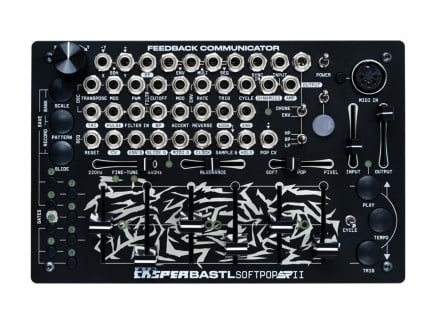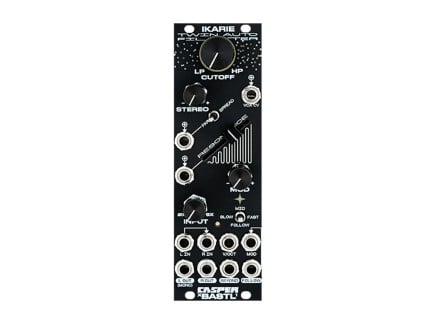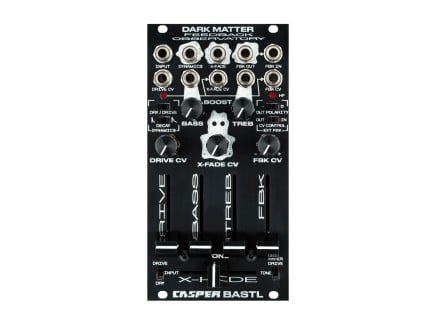If you're the sort of person who likes bizarre desktop semi-modular synths, experimental grooveboxes, squelchy filters, bubbling sonic gestures, frantically cascading arpeggios, and live performance-oriented instrument design, you're in luck: Bastl Instruments has just announced their newest instrument, the SoftPop 2.
Designed in collaboration with Pete Edwards of Casper Electronics, SoftPop 2 revives all the things we loved about the original SoftPop with (in our opinion) a significantly improved user experience, a host of additional utilities, and some altogether new features that render it a formidable-yet-fun tool for live performance and patching experimentation in a variety of musical styles. We're going to take a look at everything the SoftPop 2 contains, but given the cult status of its predecessor, I want to take a minute to discuss where the SoftPop came from, and to understand that, we need to understand a couple of other things—who is Rob Hordijk? And who is Pete Edwards?
Who is Rob Hordijk?
Rob Hordijk was not directly involved in the design of the SoftPop—so...why are we talking about him? Well, understanding his work can give us greater perspective on how SoftPop came to be—so let's talk briefly about a couple of his particularly relevant accomplishments.
Rob Hordijk is a synthesizer designer well-known in the modular community, but relatively obscure in other corners of the synth universe. Deeply involved in the development and documentation of Clavia's Nord Modular synthesizer, Hordijk has a rich, multifaceted understanding of digital signal processing and analog circuit design...and eventually, his own curious and fascinating takes on synthesis concepts began to manifest as their own instruments. Described in an article for Leonardo Music Journal in 2009, Hordijk's Blippoo Box was the first such device: a "chaotic electronic music instrument, bent by design."
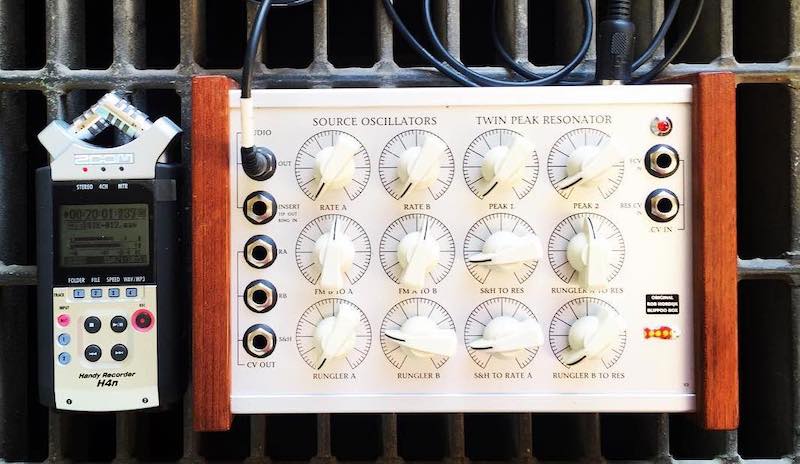
The Blippoo Box has retained a certain sort of cult status—it is a handmade instrument, only assembled in small batches, with its own unique sonic charm. The core of this instrument's spirit hinges on its embrace of chaos theory, specifically in its extensive use of control feedback to create an enormous range of volatile, yet relatively stable sonic interactions. On paper, this instrument is quite simple: it is comprised of two oscillators, a peculiar dual filter, a sample and hold, comparator, and a "rungler," a sort of primitive pseudo-random CV generator based around a simple shift register (described in greater depth on this Signal article on randomness in synthesizers). While that might seem simple, its internal embrace of control path feedback makes it such that its internal sub-modules influence one another's behavior in complex combinations of ways as dictated by the twelve knob settings, yielding some much more animated, gurgly, and peculiar than its panel might suggest. It makes resonant glass-like pings, uncanny chattering rhythms, and almost digital glitch-like textures, and can seam almost alive given its immediacy and responsiveness. As such, the Blippoo Box has become a prized tool among experimental improvisors looking for unpredictable, yet highly compelling sound source to interact with in real time. (Note: for a good sense of how the Blippoo Box sounds, check out Richard Scott's album Gurgle, Sputter, Rungle: Blippoo Box Solos.)
Alongside the Blippoo Box, Rob Hordijk developed another instrument called the Benjolin, now a long-standing favorite among chaos-loving modular synthesists. The Benjolin has gone through many iterations produced by many companies, but originally, it was Rob Hordijk's offering to the DIY community: a chaotic, "bent by design" instrument meant to be assembled at workshops or from sanctioned kits. The Benjolin is similar to the Blippoo Box, with two oscillators, a rungler, a single filter, and similar internal chaotic signal routing options. It offered a similar style of gestural pseudo-randomness, wide-range oscillators, and a filter optimized for everything from wet rhythmic thuds to squelchy acid-like resonance. It chatters, squeaks, and drones every bit as strongly as the Blippoo Box, and because of its open-source nature, it became a go-to for synth DIY enthusiasts in the early 2000s. Quickly, Hordijk's designs became pivotal to many synth DIY-ers, with their unique embrace of chaos and their ability to go from sounding like a TB-303 to an avalanche of frogs and clay pots at a moment's notice. (Note: check out this video lecture, in which Rob Hordijk explains the Benjolin for more detail!)
With that little bit of background in mind, let's tackle the next question: who is Pete Edwards?
Who is Pete Edwards, and What is Casper Electronics?
Pete Edwards is the person behind Casper Electronics—yet another obscure-yet-fascinating force in the world of underground electronic music and peculiar instrument design. I originally stumbled across Casper Electronics when researching Hordijk's work around 2010 or so; I was looking for information about the Blippoo Box and Benjolin, and unexpectedly found a treasure trove of information about electronic instrument design.
Around 2010, Casper Electronics was a go-to internet resource for information about circuit bending; Edwards's website essentially acted like a blog documenting all of his various expeditions into the weird world of hacking audio hardware. At this time, circuit bending was generally a hot topic amongst electronic music weirdos: something about reclaiming society's obsolete trash, turning it around, and discovering something unnoticed hiding inside it fit particularly well with the experimental electronic music zeitgeist. Edwards, a much-loved and quite creative circuit bender, published a huge range of tutorials and schematics on his site, helping countless people get started with their own circuit bending through general-purpose tips and bending advice for specific toys, synths, microcontrollers, and pedals. He even documented (and sold) several of his own designs, from the Nova Drone and OMSynth MiniLab synth development platform.
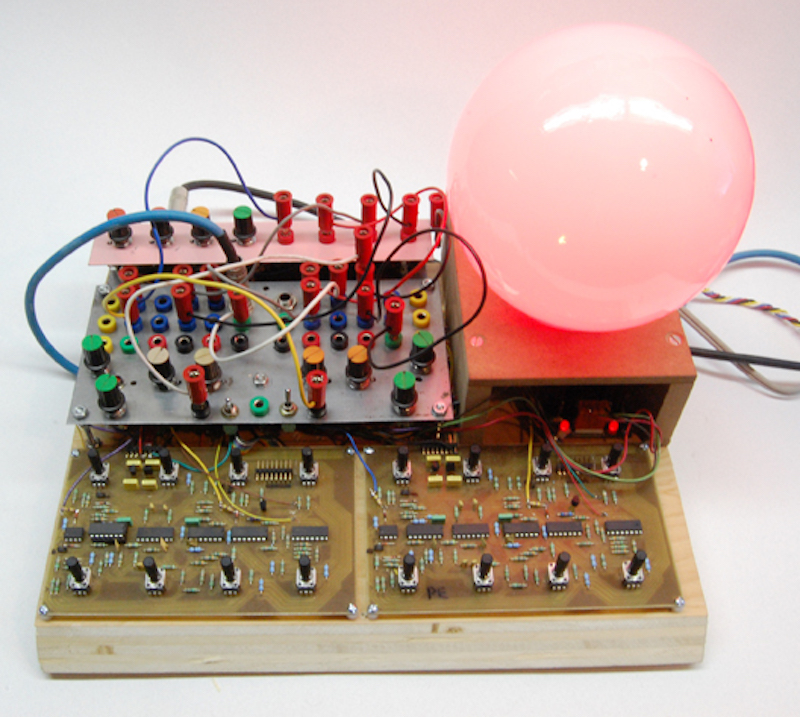 Pete Edwards's Benjolin Light Synth—remember this orb!
Pete Edwards's Benjolin Light Synth—remember this orb!
While Edwards' site was full of instructions on modding everything from BOSS and MXR effect pedals to Barbie karaoke machines, I found it because of several articles about Hordijk's Benjolin. Edwards had by that point developed several adaptations of the Benjolin, and hosted pages documenting Hordijk's original version as well as several of his own design tweaks, including a double Benjolin, the Benjola (a combination of the Benjolin and Hordijk's voltage-controllable delay circuit, Zeitgeist), and a particularly interesting/peculiar instrument called the Benjolin Light Synth, which combined two Benjolins with high-intensity LEDs and a diffuse orb to create a bizarre, interactive audio-visual experience.
Another design that always jumped out at me was the Modular Benjolin—a device based on the basic Benjolin circuits, with extensive additions that made it into a more flexible modular device (whereas the original Benjolin design was focused on internal connections rather than external connectivity or patchability). Demos of this device on YouTube were labeled as "modular analog groove synth," and that made it much more obvious to me—a nerd scouring the internet for Benjolin info—that the Benjolin wasn't just a chaotic noisemaker. In fact, it had a lot in common with classic grooveboxes like the TB-303: a simple architecture, a characterful filter, and an internal means of "sequencing" (albeit by the rungler, and not a step sequencer).
So, the next development in our story didn't exactly come as a surprise.
SoftPop: a Psychedelic Analog Synth Creature
In July of 2017, Bastl Instruments announced a partnership with Pete Edwards/Casper Electronics—the SoftPop, a "psychedelic analog synth creature" designed to be played by "anyone with a bit of playful curiosity." From the get-go, it was explained as a chaotic synthesizer that hinged on an internal feedback system with a simple, intuitive, six-fader interface. It featured a dedicated oscillator, a cycling envelope, a resonant filter, a track & hold circuit, and a number of normalled connections between these circuits...sound familiar? Given Edwards' involvement in Benjolin-based projects, it doesn't at all seem a stretch to assume that SoftPop was the culmination of an obsession with Hordijk designs: it has a sound, user experience, and overall character quite similar to the Blippoo Box and Benjolin. (See the 2017 introduction video for the original SoftPop below.)
However, SoftPop also seemed to take these concepts into a new direction, borrowing ideas from circuit bending, modular synthesis, and classic bass synths/grooveboxes to create an instrument with its own sort of sonic character. It featured a patch bay with breadboard-style jumper wires for expanded functionality, and had the ability to interface with external modular equipment via six 3.5mm<>Dupont jumper adapters. It also notably featured a motion recorder-style sequencer, a simple built-in quantizer, external input with envelope follower, and replaced a second oscillator with a multi-function envelope, which could be set to cycle up to audio rates or to simply act like a regular envelope. So, while much of its character did hinge on its chaotic nature, it also leaned heavily on the uncanny similarity in sound between the slurpy, chaotic nature of something like a Blippoo Box and the sounds of classic sequenced acid bass lines...giving it its own weird niche in the already niche history of small, chaotic, self-contained synthesizers.
SoftPop was discontinued after a very successful run and has retained a consistently present cult status—and, having not bought one as part of its initial go-around, I personally have missed it ever since. Edwards has since gone on to collaborate with Bastl on a number of designs since, including the incredible Ikarie stereo filter, Waver waveshaper, and Dark Matter feedback module. But now, Bastl has announced what many of us have been waiting for: SoftPop 2.
SoftPop 2 is Awesome
SoftPop 2 is described by Bastl as the lovechild of Pete Edwards and Bastl's Václav Peloušek, building on the foundation of the original while significantly adding to its feature set for a much more complete, thoroughly thought-out, and professional instrument. While the original is still a spectacular instrument, SoftPop 2 takes the entire concept a step further to create a profoundly playable and flexible instrument that can easily integrate into any number of setups.
So what is SoftPop 2? What does it contain, and how does it differ from the original? Well, it's fairly similar to the original: it is a semi-modular synth with a dedicated triangle/pulse oscillator, a resonant filter, a looping envelope/modulation oscillator, a built-in pattern recorder/sequencer, a sample & hold, an external input/envelope follower, an an excellent glowing orb (remember the Benjolin Light Synth?). But it also adds quite a bit—PWM CV input for the main oscillator, a manual crossfader with normalled connections to voltage offsets, a 4-way signal multiple, MIDI input, an expanded sequencer, the Pop parameter (more on that in a moment), plenty of additional patch points perfect for modular-style experimentation, and much more.
SoftPop 2 retains a control layout similar to the original, with six primary sliders for the oscillator frequency, filter frequency, envelope duration, envelope shape, and modulation inputs levels for the oscillator and filter. Normalled connections between the oscillator, envelope, sample & hold, and filter make it such that SoftPop can easily accomplish all of the intuitive gestural chaos of the predecessor—but it features a number of refinements to the user interface and sequencing capabilities that provide it extra potency in a wide range of musical scenarios.
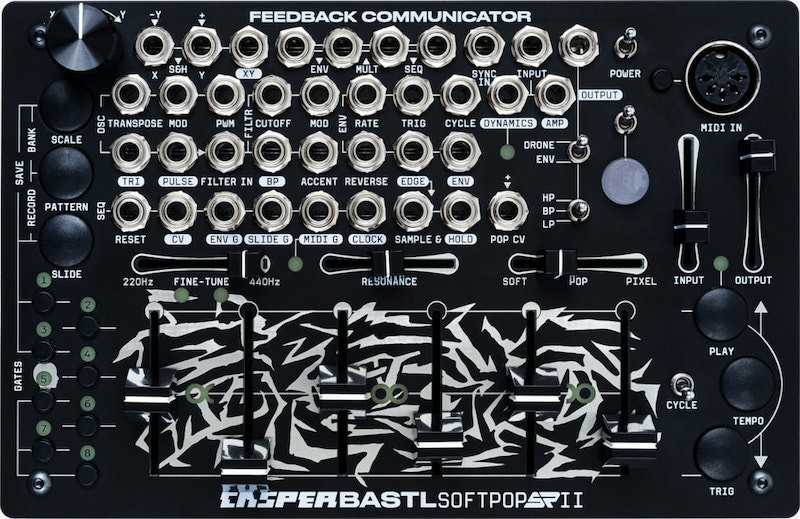
Of course, the star of the show is the new patch bay, which ditches breadboard jumper wire in favor of full 3.5mm connections, making it much easier to self-patch and to integrate into a setup with Eurorack modules or other desktop semi-modular synthesizers—of which there are now many more than there were at the point of the original SoftPop's introduction. And given all of the extra CV utilities built in, this strikes me as a much more fully-featured modular instrument than the prior iteration, with tons of options for customizing behavior via patching alone, and with a more solid/less fiddly interface than its predecessor. Patching between it and other modular/CV-capable devices is as simple as plugging in a patch cable, making it far more immediate in a ton of use cases. I'll no doubt be pairing it with my Strega and 0-Ctrl when the time comes. Also perhaps worth noting—this iteration does feature a simple end-of-chain VCA which can be set to drone or respond to the envelope via a switch, whereas the prior version had no way of dynamically controlling the output level.
One unique new sonic feature of the SoftPop 2 is the "Pop" parameter, which goes from Soft to Pixel. This is a unique distortion effect than hinges on using the oscillator's pulse output to modulate the filter's cutoff frequency, creating everything from subtle fizz to pseudo-bitcrushed sounds and spacetime-tearing distortion. Of course, this could always be patched—but having a dedicated slider for introducing this effect compounds the instrument's chaotic playability in an immediate and fun way.
SoftPop 2's sequencer is also considerably expanded from its predecessor. As before, the 8-step sequencer records pitch information by recording motion on the oscillator's slider (and even the oscillator mod depth slider)—but from there, things become considerably more complex. The sequencer features eight programmable gates, per-step slide, memory for eight patterns, memory for pattern chaining, a programmable quantizer, plenty of play modes, and even temporary playable sequence effects, allowing performative manipulation of your sequenced patterns. And if motion recording isn't your style, you can actually step edit the sequencer as well, enabling slightly more predictable, non-real-time sequence programming. It's also worth noting here that the oscillator features a dedicated quantized "Transpose" CV input, which allows you to use the built-in (editable!) quantizer to transpose sequences or to quantize external CV altogether.
And of course, the ability to sync the sequencer to an external MIDI clock (and even to use MIDI to play the oscillator or change quantizer scale) means that it's dead simple to tie the SoftPop 2 into any CV or MIDI-centric setup.
Poppin' Off
All in all? I'm thrilled that SoftPop is back. While the original is incredible as it is, I always had the feeling that it would benefit from a slightly re-worked presentation and user interface. And while an exact copy of the original with a 3.5mm patch bay would've satisfied all of my complaints about the original, SoftPop 2 takes things further—surfacing all the most useful parameters and patch points of each individual submodule and refining its built-in sequencing capabilities. And while I couldn't possibly dive into all of its potential uses here, I'm quite thrilled to imagine everything it will be capable of doing.
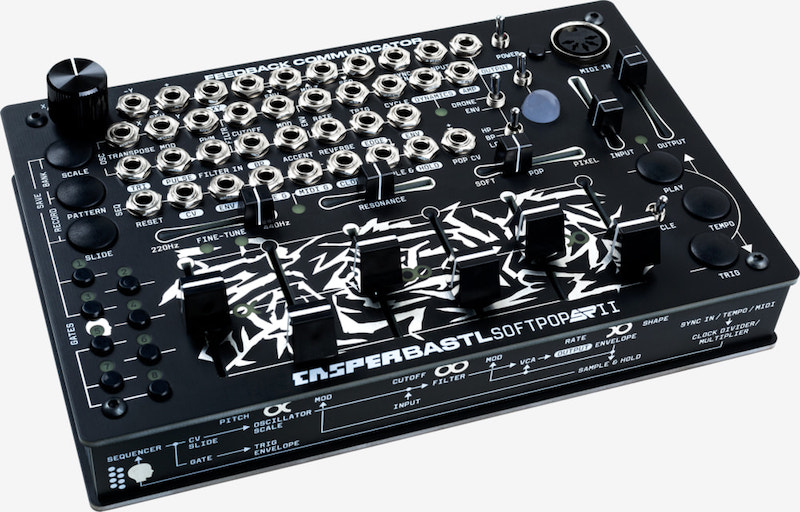
While I have a deep fondness for odd, self-contained chaotic noise boxes, I'm certain that SoftPop 2 will appeal to more than just the typical synth noise weirdo: it's a fully capable groovebox, lead synth, and modular system all in its own right. And frankly, as with other semi-modular devices around the same price range, I'm astonished at everything Bastl has managed to provide at this price point. In fact, I think the SoftPop 2 is an equally solid choice for veteran modular synth users or anyone looking to get a taste of what modular synthesis is all about.
So, do you like gurgling chaos? Glitchy, sputtery rhythms? Sequenced acid bass lines? A performance interface that will consistently surprise and delight you? If you answered "yes" to any of these questions, SoftPop 2 will prove to be a thrill.

